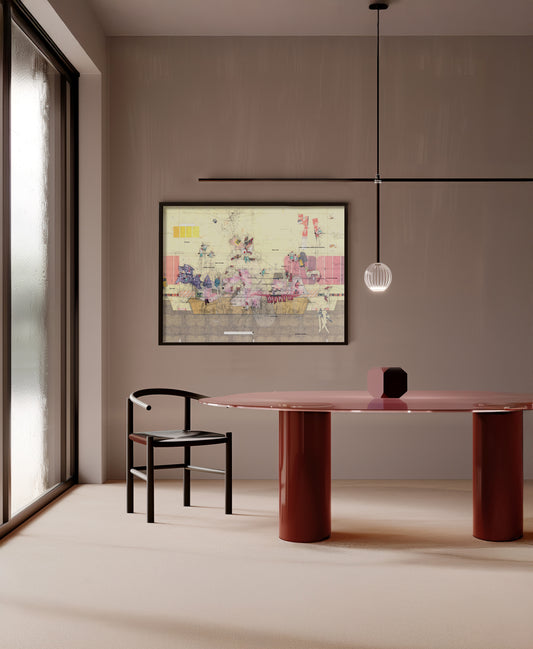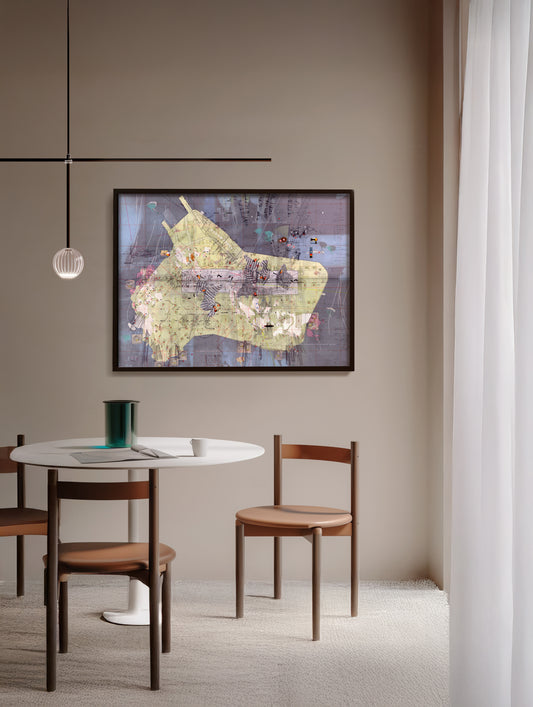Perry Kulper stands out in the architecture world for his unique drawing methods and teaching approach. As a former professor at the SCI-Arc and now at University of Michigan, Kulper has pushed beyond standard architectural drawings to develop his own visual language. His work combines unexpected elements, layered information, and experimental techniques that question how architects can think about and present their ideas. We talked with Perry about his drawings, his teaching philosophy, and why he believes architectural representation should be more than just showing buildings.
MUSE: Hi Perry, it is a pleasure to have you here today. So perhaps in short, what initially drew you to architecture when you were young?
PERRY: Good question. I had a drafting teacher in high school, and I had expressed an interest in architecture. He said, "You'll never be an architect because you don't draw fast enough." I said, hmm, that's a charge or that's an aspiration. And then the other part of it was my dad was, when he was alive, a fine cabinet maker and a contractor. So I was around building a little bit. Those two things got me interested.

MUSE: So you're more like an artist? As you may know, some architects are model makers, some of them are artists. Are you more on the artist side?
PERRY: Well, I’ve tried to learn a bit about art histories and their techniques—their cultural forms of communication. So I use art techniques or filmic techniques sometimes. I'm happy to be cross-disciplinary in terms of resources and things I refer to in my work. Maybe—maybe. I often get asked that question.
MUSE: Was there a particular moment, mentor, or experience that shaped your artistic journey?
PERRY: It would be when I worked for Bob Venturi, Robert Venturi, and Denise Scott Brown. I had read Complexity and Contradiction as a student at Columbia, and that had a huge influence on me—things to do with ambiguity, multiplicities, and the difficulty of holding those ideas together. After I finished working with Denise and Bob, I moved to Los Angeles. I started teaching at SCI-Arc. The combination of those two things opened things up a lot for me in terms of what I thought was possible.
MUSE: Your work has a distinct visual and conceptual approach. What key influences shaped how you draw or develop your style?
PERRY: Early on, I was looking at a lot of maps, historical maps. Some of my mapping thinking comes from when I was studying medieval maps, meteorological maps. That’s a part of it. Then, people like Robert Rauschenberg. And other American painters—things to do with assemblage. I was looking at things where I could mix mediums. That led me to using language, figurative elements, notations, and so forth in the same drawings. So painters were probably important, and then, collage, assemblage, photomontage—those things were important to me early on.

MUSE: And how do you develop a concept into a drawing? Some architects think by drawing, others have a different design process. How do you transform an idea into a drawing?
PERRY: It depends on what kind of work I'm doing. For things like the speculative house, garden, and landscape projects, they’re hour-long Photoshop studies. I had an idea about those things—house, garden, and landscapes. Then, I needed to learn some Photoshop skills. So I started that way, appropriated a couple of images, and worked with them.
Other times, like the David’s Island work, I had 12 to 15 key ideas, and then I gave the strategic plot a series of tasks. I gave the drawing a kind of program and started making marks that had to do with temporal conditions, migration, mobility, and vision. I began to build up a series of marks that structured what I was after—the kind of program for the drawing—and to contact the content or the ideas I was working with. It really varies from project to project in terms of how I begin.
MUSE: Given your experience in both academia and practice, how do you view the state of architecture as a profession today?
PERRY: As you know, I’ve been lucky to work with really interesting people, both in practice and academia. One of the biggest questions in architecture today—beyond environmental issues, equality, and political dimensions of spatial realms—is the scope of architecture.
What responsibilities do architects need to articulate? How much should a body of work discuss? Architecture today isn’t just about making buildings. It should consider histories, environmental impact, political agendas, and cultural content. Sometimes, I think we need to escape typology. Traditional architectural categories frame and limit what spatial realms can discuss.
The world today is incredibly complex, and I’m not sure conventional architectural techniques, typologies, or programming methods are sufficient to address that complexity. Of course, environmental concerns matter. But also—who is excluded from architectural conversations? Who is marginalized? Who is left out? Architecture has been an exclusive field for centuries.

MUSE: I agree. I think architects need to question things constantly—why are we doing this? Why this way?
PERRY: Absolutely. That’s why I always tell my students—architecture should be a generous discipline. It should care. But I also think architects today need to be many architects at once. The traditional notion of the architect as the single "author" of a project is outdated. We need to extend our awareness—to become "others," human and non-human. Architects should occupy spaces beyond their own expertise and self-interests.
MUSE: If you were to give one piece of advice to young architects, what would it be?
PERRY: One would be to stay aware of the ecology of relationships connected to their work.
PERRY: Every architectural decision has explicit and implicit consequences. For example, if you’re choosing wood cladding for a building, you should also think about deforestation, the labor conditions of the workers who harvested that wood, and the broader economic system behind it.
Architects should be more conscious of histories, etymologies, and knowledge systems—not just design trends.
We participate in optics, geometry, mathematics, philosophy, language, and cultural histories, often without realizing it. I don’t think we, as architects, are fully aware of our role in these continuities. That’s something I think young architects should focus on.
MUSE: That’s a great takeaway.
PERRY: Yeah, and also—thinking critically about design methods. How we work on things matters. Some methods include and exclude certain ideas by default. So, being intentional about how we approach design is crucial.
MUSE: Thank you, Perry. This has been such an insightful conversation.






